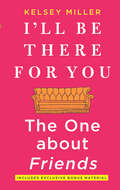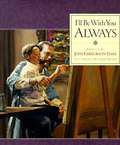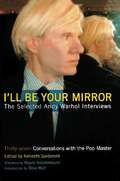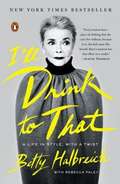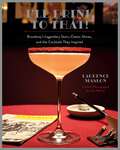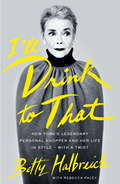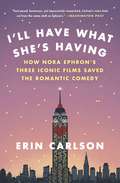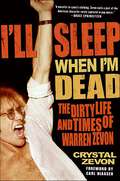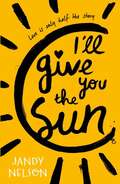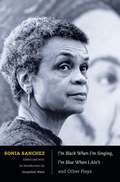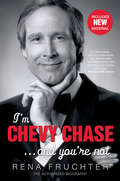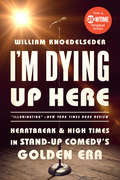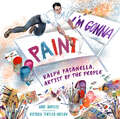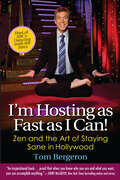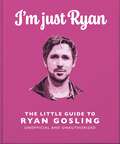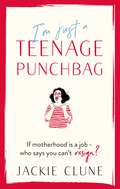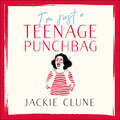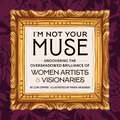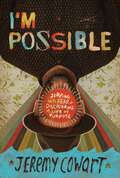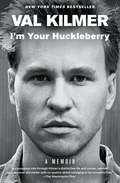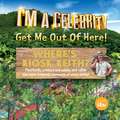- Table View
- List View
I'll Be There for You: The One about Friends
by Kelsey MillerToday, Friends is remembered as an icon of ’90s comedy and the Must See TV years. But when the series debuted in 1994, no one anticipated the sensation it would become. From the first wave of Friends mania to the backlash and renaissance that followed, the show maintained an uncanny connection to its audience, who saw it both as a reflection of their own lives and an aspirational escape from reality. In the years since, Friends has evolved from prime-time megahit to nostalgic novelty, and finally, to certified classic. Ross, Rachel, Monica, Chandler, Joey and Phoebe have entered the pantheon of great television characters, and yet their stories remain relevant still. <p><p> I’ll Be There for You is a deep dive into Friends history and lore, exploring all aspects of the show, from its unlikely origins to the societal conditions that amplified its success. Journalist and pop culture expert Kelsey Miller relives the show’s most powerful moments, sheds light on its sometimes dated and problematic elements, and examines the worldwide trends that Friends catalyzed, from contemporary coffee culture to the wildly popular ’90s haircut The Rachel. Taking readers behind the scenes, Miller traces the cast’s rise to fame and untangles the complex relationship between the actors and their characters. Weaving in revelatory interviews and personal stories, she investigates the role of celebrity media, world-changing events and the dawning of the digital age—all of which influenced both the series and its viewers. <p> I’ll Be There for You is the definitive retrospective of Friends, not only for fans of the series, but for anyone who’s ever wondered what it is about this show—and television comedy—that resonates so powerfully.
I'll Be With You Always
by Joni Eareckson TadaA disillusioned artist, who feels his tallent will never match that of his father, is restored by the older man's love and faith.
I'll Be Your Mirror: The Selected Andy Warhol Interviews
by Kenneth GoldsmithThe Question-and-Answer interview was one of Andy WarholOCOs favorite communication vehicles, so much so that he named his own magazine after the form. Yet, never before has anyone published a collection of interviews that Warhol himself gave. IOCOll Be Your Mirror contains more then thirty conversations revealing this unique and important artist. Each piece presents a different facet of the Sphinx-like WarholOCOs ever-evolving personality. Writer Kenneth Goldsmith provides context and provenance for each selection. Beginning in 1962 with a notorious interview in which Warhol literally begs the interviewer to put words into his mouth, the book covers WarholOCOs most important artistic period during the OCO60s. As Warhol shifts to filmmaking in the OCO70s, this collection explores his emergence as socialite, scene-maker, and trendsetter; his influential Interview magazine; and the Studio 54 scene. In the 80s, his support of young artists like Jean-Michel Basquait, his perspective on art history and the growing relationship to technology in his work are shown. Finally, his return to religious imagery and spirituality are available in an interview conducted just months before his death. Including photographs and previous unpublished interviews, this collage of Warhol showcases the artistOCOs ability to manipulate, captivate, and enrich American culture. "
I'll Drink to That
by Betty Halbreich Rebecca PaleyEighty-six-year-old Betty Halbreich is a true original. A tough broad who could have stepped straight out of Stephen Sondheim's repertoire, she has spent nearly forty years as the legendary personal shopper at Bergdorf Goodman, where she works with socialites, stars, and ordinary women off the street. She has helped many find their true selves through clothes, frank advice, and her own brand of wisdom. She is trusted by the most discriminating persons--including Hollywood's top stylists--to tell them what looks best. But Halbreich's personal transformation from a cosseted young girl to a fearless truth teller is the greatest makeover of her career. A Chicago native, Halbreich moved to Manhattan at twenty after marrying the dashing Sonny Halbreich, a true character right out of Damon Runyon who liked the nightlife of New York in the fifties. On the surface, they were a great match, but looks can be deceiving; an unfaithful Sonny was emotionally distant while Halbreich became increasingly anguished. After two decades, the fraying marriage finally came undone. Bereft without Sonny and her identity as his wife, she hit rock bottom. After she began the frightening process of reclaiming herself and started therapy, Halbreich was offered a lifeline in the form of a job at the legendary luxury store Bergdorf Goodman. Soon, she was asked to run the store's first personal shopping service. It was a perfect fit. Meticulous, impeccable, hardworking, elegant, and--most of all--delightfully funny, Halbreich has never been afraid to tell it to her clients straight. She won't sell something just to sell it. If an outfit or shoe or purse is too expensive, she'll dissuade you from buying it. As Halbreich says, "There are two things nobody wants to face: their closet and their mirror." She helps women do both, every day.
I'll Drink to That
by Betty Halbreich Rebecca PaleyThe stunning true story of Bergdorf Goodman's legendary personal shopperEighty-six-year-old Betty Halbreich is a true original who could have stepped straight out of Stephen Sondheim's repertoire. She has spent nearly forty years as the legendary personal shopper at Bergdorf Goodman, where she works with socialites, stars, and ordinary women off the street. She has helped many find their true selves through fashion, frank advice, and her own brand of wisdom. She is trusted by the most discriminating persons--including Hollywood's top stylists--to tell them what looks best. But Halbreich's personal transformation from cosseted young girl to fearless truth teller is the greatest makeover of her career.cades, the fraying marriage finally came undone. Bereft without Sonny and her identity as his wife, she hit rock bottom.After she began the frightening process of reclaiming herself and started therapy, Halbreich was offered a lifeline in the form of a job at the legendary luxury store Bergdorf Goodman. Soon, she was asked to run the store's first personal shopping service. It was a perfect fit.Meticulous, impeccable, hardworking, elegant, and--most of all--delightfully funny, Halbreich has never been afraid to tell it to her clients straight. She won't sell something just to sell it. If an outfit or shoe or purse is too expensive, she'll dissuade you from buying it. As Halbreich says, "There are two things nobody wants to face: their closet and their mirror." She helps women do both, every day.
I'll Drink to That
by Betty Halbreich Rebecca PaleyThe stunning true story of Bergdorf Goodman's legendary personal shopperEighty-six-year-old Betty Halbreich is a true original who could have stepped straight out of Stephen Sondheim's repertoire. She has spent nearly forty years as the legendary personal shopper at Bergdorf Goodman, where she works with socialites, stars, and ordinary women off the street. She has helped many find their true selves through fashion, frank advice, and her own brand of wisdom. She is trusted by the most discriminating persons--including Hollywood's top stylists--to tell them what looks best. But Halbreich's personal transformation from cosseted young girl to fearless truth teller is the greatest makeover of her career.cades, the fraying marriage finally came undone. Bereft without Sonny and her identity as his wife, she hit rock bottom.After she began the frightening process of reclaiming herself and started therapy, Halbreich was offered a lifeline in the form of a job at the legendary luxury store Bergdorf Goodman. Soon, she was asked to run the store's first personal shopping service. It was a perfect fit.Meticulous, impeccable, hardworking, elegant, and--most of all--delightfully funny, Halbreich has never been afraid to tell it to her clients straight. She won't sell something just to sell it. If an outfit or shoe or purse is too expensive, she'll dissuade you from buying it. As Halbreich says, "There are two things nobody wants to face: their closet and their mirror." She helps women do both, every day.
I'll Drink to That!: Broadway's Legendary Stars, Classic Shows, and the Cocktails They Inspired
by Laurence MaslonBroadway has always raised a glass to celebrate itself—what&’s an opening night without popping the cork of a bottle of Champagne? I&’ll Drink to That! Broadway&’s Legendary Stars, Classic Shows, and the Cocktails They Inspired is a celebration of theatrical tradition, a souvenir of magic moments on stage, and a practical guide to concocting one-of-a-kind craft cocktail recipes inspired by the classics of the American stage. I&’ll Drink to That! expertly mixes clever cocktails that pay homage to unforgettable Broadway shows--such as the Rainbow High from Evita and the Sidecar Named Desire--with authentic recipes for drinks that played supporting roles in beloved shows--like the legendary Vodka Stinger from Company--and shakes it up with a history of the cocktail on Broadway, detailed by one of the leading musical theater historians, Laurence Maslon. Featured throughout are fantastic images—from intoxicating images of classic shows to portraits of effervescent stage celebrities to vintage liquor ads featuring Broadway stars. Of course, the drinks themselves get their own spotlight, photographed by the legendary Broadway photographer Joan Marcus at the iconic Sardi&’s restaurant, home to hundreds of opening nights over the past century. With drinks ranging from the South Pacific-inspired Bali Ha&’i Ma&’i Ta&’i to Mame&’s Cornhusker mint julep to the Hamilton My Shot, and illustrated with a wide range of rare drawings, posters, and advertisements,, I'll Drink to That! is the perfect gift for anyone who loves the theater, enjoys an elegant bend of the elbow, and wants to be part of a long and bubbly theatrical history. 30 DRINK RECIPES: Dozens of delicious drink recipes from pre-theater cocktails to cozy after-theater toddies to celebratory toasts guaranteed to earn a standing ovation! COCKTAILS WITH A TWIST: Clever takes on Broadways shows and show tunes, including the Toast of Mayfair (Cabaret), the Bloody Sweeney (Sweeney Todd), and the Dead Thing (Beetlejuice). STARS OF THE SHOW: Classic recipes for drinks that feature center stage in famous plays and musicals, such as the Vodka Stinger from Company and the Sazerac from State of the Union. BROADWAY&’S BUBBLY HISTORY: Dive deep into dozens of stories and anecdotes about how cocktails and drinking played a role in creating some of Broadway&’s greatest hits. PHOTOS BY A LEGEND IN A LEGENDARY PLACE: Drinks photographed by the legendary Broadway photographer Joan Marcus in Broadway&’s most famous theater restaurant, Sardi&’s.
I'll Drink to That: New York's Legendary Personal Shopper and Her Life in Style - With a Twist
by Betty HalbreichBetty Halbreich is a true original. Now in her eighties, she has spent nearly forty years at the luxury store Bergdorf Goodman, working with socialites, stars and ordinary women. She has led many to appreciate their real selves through clothes, frank advice and her unique brand of wisdom; she is trusted by the most discriminating persons - including Hollywood's top stylists - to tell them what looks best. But her own transformation from cosseted girl to fearless truth-teller is the greatest makeover of all.Born into a successful Chicago family, aged twenty Betty married dashing Sonny Halbreich and came to Manhattan, where the couple threw themselves into a whirlwind of long hours, cocktails and Park Avenue parties, living the high life in 1950s New York. However, the marriage began to fray and after two decades came undone completely. Bereft, Betty attempted suicide. As she embarked on the frightening process of reclaiming herself, she was offered a lifeline: a job at Bergdorf Goodman. For Betty, with her innate sense of style and craftsmanship, it was a perfect fit.Hardworking, elegant, and gifted with sparkling wit and razor-sharp powers of observation, in her amazing life story as in her style guidance Betty Halbreich is never afraid to tell it straight.
I'll Have What She's Having: How Nora Ephron's Three Iconic Films Saved the Romantic Comedy
by Erin CarlsonA backstage look at the making of Nora Ephron's revered trilogy--When Harry Met Sally, You've Got Mail, and Sleepless in Seattle--which brought romantic comedies back to the fore, and an intimate portrait of the beloved writer/director who inspired a generation of Hollywood women, from Mindy Kaling to Lena Dunham.In I'll Have What She's Having entertainment journalist Erin Carlson tells the story of the real Nora Ephron and how she reinvented the romcom through her trio of instant classics. With a cast of famous faces including Rob Reiner, Tom Hanks, Meg Ryan, and Billy Crystal, Carlson takes readers on a rollicking, revelatory trip to Ephron's New York City, where reality took a backseat to romance and Ephron--who always knew what she wanted and how she wanted it--ruled the set with an attention to detail that made her actors feel safe but sometimes exasperated crew members. Along the way, Carlson examines how Ephron explored in the cinema answers to the questions that plagued her own romantic life and how she regained faith in love after one broken engagement and two failed marriages. Carlson also explores countless other questions Ephron's fans have wondered about: What sparked Reiner to snap out of his bachelor blues during the making of When Harry Met Sally? Why was Ryan, a gifted comedian trapped in the body of a fairytale princess, not the first choice for the role? After she and Hanks each separatel balked at playing Mail's Kathleen Kelly and Sleepless' Sam Baldwin, what changed their minds? And perhaps most importantly: What was Dave Chappelle doing ... in a turtleneck? An intimate portrait of a one of America's most iconic filmmakers and a look behind the scenes of her crowning achievements, I'll Have What She's Having is a vivid account of the days and nights when Ephron, along with assorted cynical collaborators, learned to show her heart on the screen.
I'll Sleep When I'm Dead: The Dirty Life and Times of Warren Zevon
by Crystal ZevonWhen Warren Zevon died in 2003, he left behind a rich catalog of dark, witty rock 'n' roll classics, including "Lawyers, Guns and Money," "Excitable Boy," and the immortal "Werewolves of London." He also left behind a fanatical cult following and veritable rock opera of drugs, women, celebrity, genius, and epic bad behavior. As Warren once said, "I got to be Jim Morrison a lot longer than he did."Narrated by his former wife and longtime co-conspirator, Crystal Zevon, this intimate and unusual oral history draws on interviews with Bruce Springsteen, Stephen King, Bonnie Raitt, and numerous others who fell under Warren's mischievous spell. Told in the words and images of the friends, lovers, and legends who knew him best, I'll Sleep When I'm Dead captures Warren Zevon in all his turbulent glory.
I'll give you the Sun
by Jandy NelsonNew York Times bestseller Shortlisted for the Waterstones Children's Book Prize Winner of the 2015 Michael L. Printz Award Winner of a 2015 Stonewall Honor "This is the big one - the BLAZING story of once inseparable twins whose lives are torn apart by tragedy." Entertainment Weekly From the critically acclaimed author of The Sky Is Every where, a radiant novel that will leave you laughing and crying - all at once. For fans of John Green, Gayle Forman and Lauren Oliver. Jude and her twin Noah were incredibly close - until a tragedy drove them apart, and now they are barely speaking. Then Jude meets a cocky, broken, beautiful boy as well as a captivating new mentor, both of whom may just need her as much as she needs them. What the twins don't realize is that each of them has only half the story and if they can just find their way back to one another, they have a chance to remake their world.
I'm Black When I'm Singing, I'm Blue When I Ain't: And Other Plays
by Sonia SanchezSonia Sanchez is a prolific, award-winning poet and one of the most prominent writers in the Black Arts movement. This collection brings her plays together in one volume for the first time. Like her poetry, Sanchez's plays voice her critique of the racism and sexism that she encountered as a young female writer in the black militant community in the late 1960s and early 1970s, her ongoing concern with the well-being of the black community, and her commitment to social justice. In addition to The Bronx Is Next (1968), Sister Son/ji (1969), Dirty Hearts (1971), Malcolm/Man Don't Live Here No Mo (1972), and Uh, Uh; But How Do It Free Us? (1974), this collection includes the never-before-published dramas I'm Black When I'm Singing, I'm Blue When I Ain't (1982) and 2 X 2 (2009), as well as three essays in which Sanchez reflects on her art and activism. Jacqueline Wood's introduction illuminates Sanchez's stagecraft in relation to her poetry and advocacy for social change, and the feminist dramatic voice in black revolutionary art.
I'm Chevy Chase ... and You're Not: The Authorized Biography
by Rena FruchterChevy Chase is a much-loved Hollywood star. His success as a writer and actor on Saturday Night Live in the 70s made him a household name. It had been a long, hard route to the top for Chevy. Behind the fame lay a childhood riddled with abuse. But his remarkable strength and determination helped him rise above it and find his talent as an actor, writer, comedian, and musician. Best known for his role in the National Lampoon Vacation series Chevy has starred in some of the greatest comedies of our time. His latest film, Funny Money, received critical acclaim at the Sarasota Film Festival.Now, for the first time, Chevy speaks openly and candidly about his career, his personal struggle with drugs, his friendship with three American Presidents, and his family life. Honest, funny and informative, this is the complex and fascinating world of Chevy Chase.
I'm Dreaming of a Green Christmas: Gifts, Decorations, and Recipes that Use Less and Mean More
by Anna GettyThe author and green living expert shares savvy tips on how to celebrate Christmas in ways that are eco-friendly and cost-conscious.Anna Getty—a chef, writer, mother, and organic living expert—helps families reduce their carbon footprint and save money while enjoying the festive traditions of Christmas. Anna advises how to best choose a tree (real or fake?), mitigate the negative effects of holiday travel, recycle post-holiday, and more. Anna also shares favorite holiday recipes for organic appetizers and homemade craft ideas such as pinecone wreaths and recycled sweater pillows. With inspiring photographs, extensive resources, and advice from the “Lazy Environmentalist” Josh Dorfman, Seventh Generation’s Jeffrey Hollender, and other leading eco-experts, families might just find that these tips help them stay green all year long—the perfect New Year’s resolution!
I'm Dying Up Here: Heartbreak and High Times in Stand-Up Comedy's Golden Era
by William KnoedelsederIn the mid-1970s, Jay Leno, David Letterman, Andy Kaufman, Richard Lewis, Robin Williams, Elayne Boosler, Tom Dreesen, and several hundred other shameless showoffs and incorrigible cutups from all across the country migrated en masse to Los Angeles, the new home of Johnny CarsonOCOs "Tonight Show. " There, in a late-night world of sex, drugs, dreams and laughter, they created an artistic community unlike any before or since. It was Comedy Camelot?but it couldnOCOt last. William Knoedelseder, then a cub reporter covering the scene for the "Los Angeles Times," was there when the comedians?who were not paid for performing?tried to change the system and incidentally tore apart their own close-knit community. In "IOCOm Dying Up Here" he tells the whole story of that golden age, of the strike that ended it, and of how those days still resonate in the lives of those who were there.
I'm Gonna Paint: Ralph Fasanella, Artist of the People
by Anne BroylesThe life of visionary folk artist and labor organizer Ralph Fasanella stunningly illustrated for picture book readers.When dared to jump, Ralph always took the dare. So begins this loving tribute to a singular artist and his tireless efforts to honor and celebrate immigrant and working-class communities through his paintings.Born in 1914 New York City to Italian immigrants, Ralph&’s youth was one of dress factories, ice deliveries, union meetings, and Momma&’s stories of the Bread & Roses Strike around the dinner table. By teaching himself how to paint, Ralph discovered a new way to reach working people: he would depict their lives, their work, and American history with electric color at a grand scale.Focusing on themes of social justice, immigrant rights, labor rights, and the dignity of working people, I&’m Gonna Paint inspires to give a new generation the confidence to continue the fight for better working conditions.Anne Broyles taps into Ralph's indomitable spirit to show his evolution as an artist, while Victoria Tentler-Krylov&’s energetic art leaps off the page with wonder and homages to Ralph&’s style. Meticulously researched with quotes from Ralph to underline his philosophy and approach to artmaking, the robust back matter includes reproductions of his paintings, historical photos, a timeline, a bibliography, a source notes, and much more.
I'm Hosting as Fast as I Can!: Zen and the Art of Staying Sane in Hollywood
by Tom BergeronIn this memoir, the charming TV host shares funny yet poignant stories from his life and career, plus his secrets to staying calm on & off camera.Tom Bergeron, Emmy Award–winning former host of Dancing with the Stars and America’s Funniest Home Videos, has always been ambitious, driven, and charming. However, as a young man, he had an enemy that posed a serious threat to what otherwise would have been guaranteed success—a bad temper. His family and friends didn’t keep their concerns to themselves, but Tom’s petulance remained a problem until his first date with a woman who threatened to end their relationship when, in a fit of anger, he put a dent in his car door. “If you want us to go any further, you’d better do something about that,” Lois said, unabashed and unafraid. Tom, embarrassed, then and there committed himself to controlling that temper. (That woman later became his wife, by the way.)This humorous memoir will be filled with anecdotes of how Tom, who never breaks character, stutters or so much as breaks a sweat (even when an Osmond faints at his feet on live TV), uses meditation and other regimented, relaxation techniques to stay focused, energetic, and happy on and off the camera.Praise for I’m Hosting as Fast as I Can!“The charm and wit that have made Tom Bergeron one of television’s most popular hosts is reflected beautifully in I’m Hosting as Fast as I Can! Readers will love Tom’s book.” —Bob Barker“You are a good man, Charlie Brown! Also an honest man, an entertaining man, a life-instructing man, and one hell of an autobiographer. Congratulations, Tom!” —Carl Reiner
I'm Just Ryan: The Little Guide to Ryan Gosling
by Orange Hippo!To his millions of fans worldwide, Ryan Gosling is not just a handsome face that can say "Hey girl!" in a way that makes them go weak at the knees (though he can and does), he is the defining icon of the new Golden Age of cinema, a 21st-century Cary Grant, as macho as he is feminine, with a total of 11 Oscar, Golden Globe and BAFTA nominations under his belt, and a Golden Globe victory for Best Actor.Since his tenure as a leading man, 20 years ago in The Notebook, Ryan's films have grossed more than $2 billion dollars, and his next few projects will certainly add to that figure, with Project Hail Mary, Wolf Man, Gray Man 2, and Margot Robbie's Ocean Eleven reboot keeping him in the La La Land limelight for many years to come.I'm Just Ryan throws a bright spotlight on the actor's playful and positive sense of humour and philosophy and revels in his ridiculous charm and sexiness with a wealth of iconic quotes and facts about the man - the legend - himself."I did doubt my Kenergy in the beginning. I just wasn't sure I could do it but I just decided I was going to Ken as hard as I can. I Kenned in the morning; I Kenned at night. If I'm honest, I'm Kenning a little right now."Ryan, on channeling his "Kenergy"."Eva's the dream mother, and they're dream babies, and it's like a dream that I'm having right now. I'm dreaming it all."Ryan, on his wife Eva Mendes.Ryan Gosling's live performance of "I'm Just Ken" at the 2024 Academy Awards is already considered one of the most iconic moments in Oscars history. Dressed head-to-toe in pink, Ryan stole the show with Guns & Rose guitarist Slash and Mark Ronson, alongside 65 other "Ken's", and his Barbie co-stars. More than 20 million people tuned in to watch and sales of the song jumped by 900 per cent during the performance.
I'm Just Ryan: The Little Guide to Ryan Gosling
by Orange Hippo!To his millions of fans worldwide, Ryan Gosling is not just a handsome face that can say "Hey girl!" in a way that makes them go weak at the knees (though he can and does), he is the defining icon of the new Golden Age of cinema, a 21st-century Cary Grant, as macho as he is feminine, with a total of 11 Oscar, Golden Globe and BAFTA nominations under his belt, and a Golden Globe victory for Best Actor.Since his tenure as a leading man, 20 years ago in The Notebook, Ryan's films have grossed more than $2 billion dollars, and his next few projects will certainly add to that figure, with Project Hail Mary, Wolf Man, Gray Man 2, and Margot Robbie's Ocean Eleven reboot keeping him in the La La Land limelight for many years to come.I'm Just Ryan throws a bright spotlight on the actor's playful and positive sense of humour and philosophy and revels in his ridiculous charm and sexiness with a wealth of iconic quotes and facts about the man - the legend - himself."I did doubt my Kenergy in the beginning. I just wasn't sure I could do it but I just decided I was going to Ken as hard as I can. I Kenned in the morning; I Kenned at night. If I'm honest, I'm Kenning a little right now."Ryan, on channeling his "Kenergy"."Eva's the dream mother, and they're dream babies, and it's like a dream that I'm having right now. I'm dreaming it all."Ryan, on his wife Eva Mendes.Ryan Gosling's live performance of "I'm Just Ken" at the 2024 Academy Awards is already considered one of the most iconic moments in Oscars history. Dressed head-to-toe in pink, Ryan stole the show with Guns & Rose guitarist Slash and Mark Ronson, alongside 65 other "Ken's", and his Barbie co-stars. More than 20 million people tuned in to watch and sales of the song jumped by 900 per cent during the performance.
I'm Just a Teenage Punchbag: POIGNANT AND FUNNY: A NOVEL FOR A GENERATION OF WOMEN
by Jackie Clune'Obligatory reading for all parents of teenagers!' NIGELLA LAWSON'Bloody marvellous. Horribly familiar, funny, touching, sad, brutally honest...clutch this book to your stained T-shirt and never let it go.' JO BRAND'Terrific. A remarkable blend of hilarity and heartbreak with a really satisfying plot. Being childless never felt so good.' GRAHAM NORTON'Warm and witty... The competitive mothering, the hell that is other people's children, the fights and accusations of Homeland inquisition all rang deliciously true... a most entertaining read.' KATHY LETTE'Very poignant... A moving read as well as a funny one.' JANE GARVEY 'Honest, hilarious and painful' WOMAN & HOMEWarning!! This novel may lead you to make rash and life-changing decisions!**Probably don't read if you fear you may be ripe for liberation. Or if you sometimes wee when you laugh...First there was Having It All, then there was Bridget Jones' s Diary and I Don't Know How She Does It. Now there is Teenage Punchbag.I'm Just A Teenage Punchbag is a laugh-out-loud, sob-on-the bus journey through the so-called life of a middle-aged woman.Ciara is mother to three ungrateful, entitled teenagers, is married to steady Martin, a man with hairy udders, and is grieving for her mum who now lives in the wardrobe in a cardboard box from the crematorium. She finds solace in her anonymous blog, and in the daily chats she has with her mum's ashes (often the best conversations she has all day.)Despite the menopause, the invisibility of middle age and the daily self-esteem bashings, courtesy of her kids, Ciara manages to navigate the stormy waters of grief and family life - until her mask slips and she is cast out from the family bosom. She embarks on a mission to fulfil her mum's dying wishes to have her remains sprinkled from the top of the Empire State Building, finding company, distraction and - ultimately - herself in the process.If motherhood is a job - who says you can't resign?
I'm Just a Teenage Punchbag: POIGNANT AND FUNNY: A NOVEL FOR A GENERATION OF WOMEN
by Jackie CluneWarning!! This novel may lead you to make rash and life-changing decisions!**Probably don't read if you fear you may be ripe for liberation. Or if you sometimes wee when you laugh...First there was Having It All, then there was Bridget Jones' s Diary and I Don't Know How She Does It. Now there is Teenage Punchbag.I'm Just A Teenage Punchbag is a laugh-out-loud, sob-on-the bus journey through the so-called life of a middle-aged woman.Ciara is mother to three ungrateful, entitled teenagers, is married to steady Martin, a man with hairy udders, and is grieving for her mum who now lives in the wardrobe in a cardboard box from the crematorium. She finds solace in her anonymous blog, and in the daily chats she has with her mum's ashes (often the best conversations she has all day.)Despite the menopause, the invisibility of middle age and the daily self-esteem bashings, courtesy of her kids, Ciara manages to navigate the stormy waters of grief and family life - until her mask slips and she is cast out from the family bosom. She embarks on a mission to fulfil her mum's dying wishes to have her remains sprinkled from the top of the Empire State Building, finding company, distraction and - ultimately - herself in the process.If motherhood is a job - who says you can't resign?(P) 2020 Hodder & Stoughton Ltd
I'm Not Your Muse: Uncovering the Overshadowed Brilliance of Women Artists & Visionaries
by Lori ZimmerAn illuminating exploration of 31 incredible women—across art, architecture, dance, literature, and more—whose culture-defining contributions have, until now, been overshadowed by their role as "muses" to history's better-known men. What does it mean to be someone's "muse"? Historically, to be called a &“muse&” among artistic circles has been marketed as a flattering title. It is a commendation that most often refers to a woman whose vivacity and beauty are the source of inspiration for a (usually) male artist or creator. Perhaps her inspiring presence is even credited in the story of his success. But the very concept of a muse underestimates these women and their abilities. At its root, muse is a support role, the title a consolation prize that claims to recognize a woman&’s greatness—but only in her support of another.I'm Not Your Muse reclaims the narrative of 31 of these extraordinary women, from "The Mother of the Movies" Alice Guy-Blaché to Modernist designer Eileen Gray, prima ballerina Maria Tallchief, storied Harlem Renaissance editor Jessie Redmon Fauset, and many more. Each of these women advanced the narrative of culture and society, pushing the boundaries of visual arts, dance and movement, commercial architecture, music, journalism, and the performing arts. Whether by historical accident or cruel design, their contributions have historically been overshadowed by those of their male counterparts, and often collaborators. In this briskly written, incisively researched compendium, author and researcher Lori Zimmer repositions these women as the main characters of their own lives. Each profile is accented with original illustrations—including jaunty portraits in playfully constructed frames—by artist Maria Krasinski. Together, they highlight the contemporary accomplishments and historical legacies of a wide-ranging group of revolutionary women. Featured women include: Louise Blanchard Bethune Claude Cahun and Marcel Moore Minnette de Silva Clara Driscoll Jessie Redmon Fauset Loie Fuller Martha Gellhorn Eileen Gray Belle da Costa Greene Alice Guy-Blaché Miss La La Edmonia Lewis Neysa McMein Hildreth Meière Lucia Moholy May and Jane Morris Na Hye-Sŏk Fernande Olivier Pan Yuliang Ethel Reed Clara Rockmore Ada Bricktop Smith Maria Tallchief Alice B. Toklas Suzanne Valadon Baroness Elsa von Freytag-Loringhoven Leonora Carrington Remedios Varo Kati Horna
I'm Possible: Jumping into Fear and Discovering a Life of Purpose
by Jeremy CowartInternationally known photographer and philanthropist Jeremy Cowart uses snapshots of his own story to inspire readers with the message that all things are possible when we actively engage our God-given purpose to change the world.Recognized as “the most influential photographer on the Internet,” Jeremy Cowart is known as a photographer, hotelier, fund-raiser, teacher, artist, world uniter, lover of life, and man of adventure. What fans don’t always know is that Jeremy started out as a failure.Growing up, Jeremy’s life was defined by the words I can’t do it. Thankfully, Jeremy’s parents reprogrammed his mind with a single sentence: I can do all things through Christ who strengthens me. That simple truth propelled Jeremy to achieve greatness in many forms, includingrunning photo shoots with A-list clients, such as Sting, the Kardashians, President Obama, the Pope, and many more,launching the Help-Portrait movement to invest dignity and value in people from underserved communities and who were victims of tragedy, andlaunching the Purpose Hotel as a for-profit hotel chain designed to fuel the work of not-for-profit organizations.I’m Possible is an extension of Jeremy’s belief that greatness must serve a greater purpose. It’s a book that will inspire readers with the message that all things are possible when we actively engage our God-given purpose to change the world.
I'm Your Huckleberry: A Memoir
by Val KilmerLegendary actor Val Kilmer shares the stories behind his most beloved roles, reminisces about his star-studded career and love life, and reveals the truth behind his recent health struggles in a remarkably candid autobiography.Val Kilmer has played many iconic roles over his nearly four-decade film career. A table-dancing Cold War agent in Top Secret! A troublemaking science prodigy in Real Genius. A brash fighter pilot in Top Gun. A swashbuckling knight in Willow. A lovelorn bank robber in Heat. A charming master of disguise in The Saint. A wise-cracking detective in Kiss Kiss Bang Bang. Of course, Batman, Jim Morrison and the sharp-shooting Doc Holliday. But who is the real Val Kilmer? With I&’m Your Huckleberry—published ahead of next summer&’s highly anticipated sequel Top Gun: Maverick, in which Kilmer returns to the big screen as Tom &“Iceman&” Kazansky—the enigmatic actor at last steps out of character and reveals his true self. In this uniquely assembled memoir—featuring vivid prose, snippets of poetry and rarely-seen photos—Kilmer reflects on his acclaimed career, including becoming the youngest actor ever admitted to the Juilliard School&’s famed drama department, determinedly campaigning to win the lead part in The Doors, and realizing a years-long dream of performing a one-man show as his hero Mark Twain. He shares candid stories of working with screen legends Marlon Brando, Tom Cruise, Robert Downey Jr. and Robert De Niro, and recounts high-profile romances with Cher, Cindy Crawford, Daryl Hannah, and former wife Joanne Whalley. He chronicles his spiritual journey and lifelong belief in Christian Science, and describes travels to far-flung locales such as a scarcely inhabited island in the Indian Ocean where he suffered from delirium and was cared for by the resident tribe. And he reveals details of his recent throat cancer diagnosis and recovery—about which he has disclosed little until now. While containing plenty of tantalizing celebrity anecdotes, I&’m Your Huckleberry—taken from the famous line Kilmer delivers as Holliday in Tombstone—is ultimately a singularly written and deeply moving reflection on mortality and the mysteries of life.
I'm a Celebrity... Where's Kiosk Keith?
by Mark Cowley and Bill HopeI'm A Celebrity's Kiosk Keith has escaped the Outback Shack and is somewhere in the jungle. Can you locate him, 10 bushtucker trial stars, and key celebrities, critters and objects? It's not as easy as you may think!This fun, family activity book includes: 17 incredible artworks, one for each season plus a bonus 'behind the scenes' artwork Photos of the show's most iconic moments Potted histories of each series, with season highlights and a list of all the delightfully gruesome bushtucker trials from every yearHosted by iconic duo Ant and Dec, I'm a Celebrity has gone from strength to strength since its first airing in 2002, becoming a hugely anticipated fixture in the nation's TV calendar. In 2016 it had its best year ever and recorded a peak audience of 12.7 million viewers... comfortably ITV's biggest show of the year.With stars, celebs and special objects waiting to be found in 17 stunningly detailed artworks, this is the perfect indulgence for every I'm a Celebrity fan.
